Iran is a country of four seasons and that`s the reason agricultural products are always available in this country. Exporting fruits and vegetables has always been active in Iran`s markets. But since fruits and vegetables are perishable products, the process of exporting, transporting, storing & etc. would be challenging and important and needs an accurate management. From the moment of harvest, fruits and vegetables will be enter to a cold chain and then they`ll be transported by special trucks, stored in a cold storage and delivered to the buyer. The temperature is one of the most important factors in this chain that keeps the produce fresh and intact.
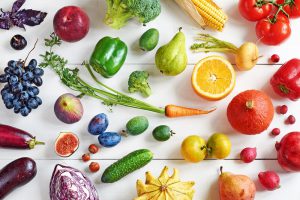
Cold chain
Cold chain is the process of temperature control from the moment of harvest to the moment of delivery to the buyer. It provides a safe, temperature-controlled environment for sensitive items such as fresh and frozen food produce, pharmaceutical products, chemicals. The cold chain is used only when the products are sensitive to temperature and deteriorate when exposed to low heat or cold.
Cold chains are essential for the transport of perishable goods. The goal of cold chains is to extend the life of products and preserve their properties.
Cold chains require trained drivers and warehousers to maintain urgent solutions in case of temperature changes, as well as people with sufficient knowledge of schedules and procedures for the coordinated and timely processing of cargo documents while passing warehouses or customs.
Each perishable product takes a different journey in the cold chain. For example, the cold chain function of food products is different from the cold chain function of pharmaceutical products.
Cold chain management is a very special and sensitive responsibility and requires expertise knowledge, different facilities, equipment and skills.

The Rules of Fruit and Vegetables Transportation
- The proper selection of the fruit and vegetables (it is forbidden to transport overripe, dirty, and rotten fruit)
- sanitation preparation of the vehicles
- every kind of product has its own minimal and maximal temperature indicators. It is necessary to follow them carefully.
- Good Hygiene Whilst Travelling.
- Proper packaging
Harvest time
Horticultural and agricultural crops are usually harvested at two times, one at physiological ripening time of the crop and the other one at the time of commercial ripening.
When the crop on the mother plant is fully ripe and all parts of it such as fruit and seeds are complete, we say physiological ripening. Products like this, usually cereals and legumes, can be used after physiological ripening and can enter the target market.
But some horticultural and agricultural crops are collected sooner or later than their physiological arrival from agricultural lands. These products won`t have the required qualities if they enter the market right at the time of physiological arrival, and the market demand for them becomes less.
The use of a fruit refrigerator for the second group is more common, and sometimes some fruits are even freeze for supply in other seasons.
Non-climacteric fruits (pineapple, grape, strawberry, citrus, pepper, zucchini), which are characterized by having a single point of ripeness, that is, they must be harvested just before consumption because if they are harvested green, they do not continue to ripen.
Climatic fruits (apple, pear, plum, banana, kiwi, tomato, peach,) characteristic for having two points of ripeness, that is, they continue to ripen after being harvested.

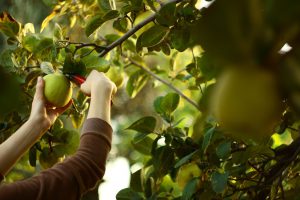
Things should be done before refrigeration of fruits
Pre-cooling
Pre-cooling is the rapid removal of heat from freshly harvested vegetables. pre-cooling avoids the wrinkled or frozen fruits. This is done with the help of a pre-cooled chamber and cold air flow in the cold storage. At this stage, according to the type of product, the ambient temperature should be reached below ten Celsius. To speed up the operation of the pre-cooler, the type of product packaging and the shape of the layout are also important.
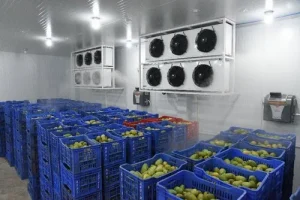
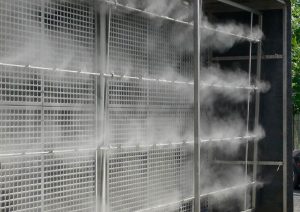
Fruit grading
After the pre-cooling stage, it is time to grade. This step is one of the most essential steps to take before refrigeration of fruits. they should be thoroughly checked for quality and health before refrigeration. Grading means the separation of high-quality products and the selection of fruits that generally have resistance to low temperatures and storage conditions in cold storage.
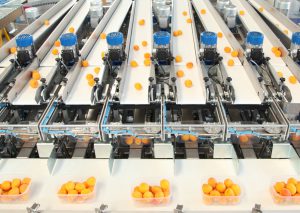

Waxing the surface of fruits
Before inserting products into the fruit refrigerator, one of the things that can be done is to wax the surface of the fruits with a special wax. With some special oils, they wax a layer of the outer surface of the product, and this will not only prevent the evaporation of water and wilting of the fruit, but also improves the appearance of fruits.
To do this process, first dissolve the special oil in a solvent or emulsifier in the form of an emulsion in the water and then pass the desired product and fruit through it. After the completion of these steps, the fruit is dried by air flow and the excess moisture is taken.

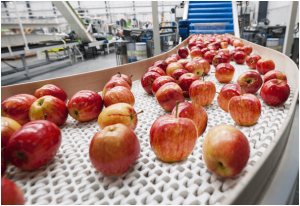
Cold storage
The refrigeration of fruits and vegetables is a very important part of the refrigeration industry as they are very perishable goods. To preserve their nutritional efficiency, it is essential to have a correct refrigeration installation.
Due to their breathing and metabolic changes, it is necessary to have a correct air renewal inside the cold storage.
The cold room storage temperature and time of fruits and vegetables is different according to different varieties of fruits and vegetables. It is related to many reasons such as: pre-cooling, quality of fruits and vegetables, varieties of fruits and vegetables, Packaging methods of fruits and vegetables, etc.
Therefore, for correct conservation of fruits and vegetables, it is necessary to know and control the characteristics of the different varieties and to have a correct refrigerating installation.
The most important factors are the existence of low temperatures, high relative humidity and proper ventilation to achieve proper ripening and not lose all the nutrients that these foods provide.
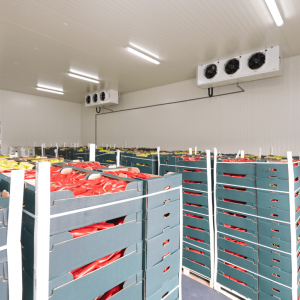

Airflow system
- It distributes the cool air equally.
- Sterilize the cold storage.
- Delays the spoilage of fruits in the cold storage.
- Eliminates bacteria in vegetables and fruits.
- It kills most of the germs that cause fruit loss.
- Preserving the taste and vitamins in fruit for a long time.
Gas control around fruits in fruit refrigerator
When the fruit is picked from the tree, it loses its nutritional supply source. but the plucked fruit continues to grow and metabolize like a living organism. then the fruit enters the physiological ripening phase within its tissue it has complex molecules, including carbohydrate categories, organic acids, amino acids and…. the minute a fruit is picked from the tree it pursues its life based on the decomposition of these chemical molecules, so that the texture and appearance of the fruit changes.
This breathing operation means breaking down complex molecules and turning them into seemingly simpler molecules. During this process, complex molecules usually produce water، carbon dioxide and some thermal energy. The respiration rate in different fruits is variable. But in general, it can be said that fruits will have the highest breathing rate by the time they reach physiological ripening, and as they progress towards ripening and aging the respiratory rate will decrease. Another point is that the slower the breathing rate of the fruit is, the more time the process of passing through the physiological stage and reaching the aging stage takes, and thus the fruit can be stored for longer.
Ethylene (C2H4) is an organic chemical compound that is one of the most commercially produced compounds in the chemical industry because of its application in the agricultural industry.
When the fruits are separated from the tree, as mentioned above, they continue to breathe. the result of this metabolic activity is the breakdown of complex molecules into simpler molecules. One of these molecules produced in the process of breathing fruits is ethylene molecule. A molecule that itself can play a catalyst for the metabolic activities of the fruit. Therefore, the presence of ethylene causes immature fruits to ripen sooner or in a process that is not controlled it will ruin the fruits.
refrigerated transportation of fruits
The most important things to consider in the refrigerated transport of fruits are:
- The use of a refrigerated truck with the right temperature in the carriage that needs to observe the proper temperature throughout the route so that the temperature of the reefer is always controlled.
- Observe the cold chain during unloading and loading of fruits and vegetables so as not to cause thermal shock.
- The importance of air circulation in the chamber where fruits and vegetables are. Fruits and vegetables also need some moisture along the way, which should be considered in the refrigerated transportation of fruits and vegetables.
- The combination of different fruits and vegetables should be checked for transportation. Most of the time, the owners of goods carry different types of fruits or vegetables together, and this combined transport in a refrigerated truck must be carried out based on the required temperature, moisture, carbon dioxide content of the products and the produced ethylene.
For example, you should always transport eggplant with no other perishable product. But you can transport Cabbage, cauliflower and celery at the same time in one truck.
| Ethylene Producers | Ethylene Sensitive |
| Avocados | Bananas (unripe) |
| Apples | Broccoli |
| Bananas (ripe) | Brussels sprouts |
| Figs | Cabbage |
| Grapes | Carrots |
| Melons | Cauliflower |
| Pears | Cucumbers |
| Peaches and Nectarines | Leafy Greens |
| Peppers | Lettuce |
| Potatoes | Onions |
| Tomatoes | Squash |
| fruit | Storage (°C) | Temperature | Storage (%) | Relative humidity | Storage (days) |
| Apple | -1-4 | 90-95 | 30-180 | ||
| Apricot | -0.5-0 | 90-95 | 7-21 | ||
| Asian pear | 1 | 90-95 | 150-180 | ||
| Atemoya | 13 | 85-90 | 28-42 | ||
| Avocado | 3-13 | 85-90 | 14-56 | ||
| Babaco | 7 | 85-90 | 7-21 | ||
| Banana /Plantain | 13-15 | 90-95 | 7-28 | ||
| Barbados cherry | 0 | 85-90 | 49-56 | ||
| Blackberry | -0.5-0 | 90-95 | 2-3 | ||
| Black sapote | 13-15 | 85-90 | 14-21 | ||
| Blueberries | -0.5-0 | 90-95 | 14 | ||
| Breadfruit | 13-15 | 85-90 | 14-42 | ||
| Caimito | 3 | 90 | 21 | ||
| Calamondin | 9-10 | 90 | 14 | ||
| Cantalupo | 0-2 | 95 | 5-15 | ||
| Carambola | 9-10 | 85-90 | 21-28 | ||
| Cashew apple | 0-2 | 85-90 | 35 | ||
| Chayote | 7 | 85-90 | 28-42 | ||
| Cherimoya | 13 | 90-95 | 14-28 | ||
| Cherries | -1-0.5 | 90-95 | 14-21 | ||
| Chicory | 0 | 95-100 | 14-21 | ||
| Coconut | 0-1.5 | 80-85 | 30-60 | ||
| Cranberries | 2-4 | 90-95 | 60-120 | ||
| Cucumber | 10-13 | 95 | 10-14 | ||
| Currants | -0.5-0 | 90-95 | 7-28 | ||
| Custard apple | 5-7 | 85-90 | 28-42 | ||
| Dates | -18-0 | 75 | 180-360 | ||
| Durian | 4-6 | 85-90 | 42-56 | ||
| Feijoa | 5-10 | 90 | 14-21 | ||
| Fig | -0.5-0 | 85-90 | 7-10 | ||
| Grape | -0.5-0 | 90-95 | 14-56 | ||
| Grapefruit | 10-15 | 85-90 | 42-56 | ||
| Guanabana | 13 | 85-90 | 7-14 | ||
| Guava | 5-10 | 90 | 14-21 | ||
| Jaboticaba | 13-15 | 90-95 | 23 | ||
| Jackfruit | 13 | 85-90 | 14-42 | ||
| Kiwano | 10-15 | 90 | 180 | ||
| Kiwifruit | -0.5-0 | 90-95 | 90-150 | ||
| Kumquat | 4 | 90-95 | 14-28 | ||
| Lemon | 10-13 | 85-90 | 30-180 | ||
| Lime | 9-10 | 85-90 | 42-56 | ||
| Longan | 1-2 | 90-95 | 21-35 | ||
| Loquat | 0 | 90 | 21 | ||
| Lychee | 1-2 | 90-95 | 21-35 | ||
| Mamey | 13-18 | 85-95 | 14-42 | ||
| Mandarin | 4-7 | 90-95 | 14-28 | ||
| Mango | 13 | 90-95 | 14-21 | ||
| Mangosteen | 13 | 85-90 | 14-28 | ||
| Melon | 7-10 | 90-95 | 12-21 | ||
| Nectarine | -0.5-0 | 90-95 | 14-28 | ||
| Olives, fresh | 5-10 | 85-90 | 28-42 | ||
| Orange | 0-9 | 85-90 | 56-84 | ||
| Papaya | 7-13 | 85-90 | 7-21 | ||
| Passionfruit | 7-10 | 85-90 | 21-35 | ||
| Peach | -0.5-0 | 90-95 | 14-28 |
Refrigerated trucks
Transportation of perishable goods can be challenging due to their short expiry date. But with the help of refrigerated trucks, it has become easier.
Refrigerated trucks (also known as reefers) due to the transportation of perishable goods, must have certain characteristics such as insulation to prevent energy loss.
Refrigerated trucks have a variety of mechanical and diesel cooling systems.
It is an insulated refrigerator unit that is installed on a chassis and designed to maintain temperature even in hot summer conditions. For these refrigerated trucks, condenser is a cooling device, which liquefies gas by cooling it.


Thermograph
A thermograph is a device that is installed on refrigerated trucks and records the temperature inside the vehicle.
This device can use its sensitive sensors to measure the ambient temperature with high accuracy and record it in its memory.
For this device, sampling rates and temperature alarm limits can be specified and then put inside the refrigerated truck.
All samples of temperature with date and time are recorded in the memory of this device, and at destination, by connecting it to the computer and observing temperature changes, we can ensure the temperature health of the products.
A contract with the driver and a commitment to the thermograph is very important, because a thermal shock will ruin the fruit. It`s necessary to work with a committed and more expensive driver to make sure that he didn’t turn off the car or run out of gas.